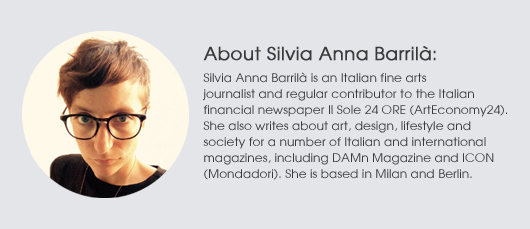The sales of Italian art held in London on Oct. 11 and 12 once again confirmed the demand for postwar Italian art at the international level. Piero Manzoni and Lucio Fontana were once more the stars of the sale, together with some of the protagonists of Arte Povera, such as Pistoletto and Luciano Fabro.
Among the modern masters, the most requested remain Giorgio Morandi and Giorgio De Chirico. Seven artist records were set for works by Michelangelo Pistoletto ($1.1 million), Luciano Fabro ($1.1 million), Arnaldo Pomodoro ($768,000), Fausto Melotti ($310,000), Nicola de Maria ($204,000), Paola Pivi ($118,000) and Vettor Pisani ($40,000). The combined total result of the two sales was $50.5 million.
Christie’s totalized $25.5 million (the second highest total since the auction house started holding a sale entirely dedicated to 20th century Italian art in 2000), with a record sold rate of 96 percent by value and 93 percent by lot.
The top price was paid for an “Achrome” by Piero Manzoni, which realized $3.7 million. Piero Manzoni’s “Achromes” are a seminal series of works that run like a constant throughout the artist’s short career (Manzoni died of heart attack when he was only 29). The work sold at Christie’s comes from a comparatively rare group of “Achromes” that Manzoni started around 1959, and was already part of prestigious collections such as the Beyeler collection and the collection of Claude Berri. It was acquired in 2008 at the same sale of Italian art at Christie’s in London for $2.6 million, which means that it raised its value for more than $1 million in four years.
Christie’s top 10 is dominated by Lucio Fontana. A quarter of the whole sale consisted of works by Fontana, and all works found a buyer. Even if the market for Lucio Fontana’s works is stable on high prices, there is still room for growth.
In a postsale commentary Mariolina Bassetti, vice chairman of Christie’s Italy, international director in the postwar & contemporary art department and head of the sale, expressed particular satisfaction for the result by Arte Povera representative Pistoletto: “Perhaps most pleasing was the price realized by Michelangelo Pistoletto’s Metrocubo d’Infinito (“Cubic Meter of Infinity”) which is not only a tribute to the artist, but also to the taste of its former owner, Graziella Buontempo, one of the greatest early ambassadors of modern Italian art.”
Sotheby’s realized a total result of $25 million with lower sold rates than Christie’s: 82 percent by value and 76 percent by lot. Again the top price was paid for an “Achrome” by Piero Manzoni, which sold for $6.4 million to a U.S. buyer, and again Manzoni was followed in the ranking by Lucio Fontana, with two exceptional works. One that sold for $3 million was a rare work from the “Cuts” series, with three geometric golden stripes accenting the central cut on a pink surface. In 2004 it was sold at Sotheby’s for $369,500, which means its value has multiplied tenfold in eight years.
The other work is another important “Cut” which was born from Lucio Fontana’s creative engagement with Venice. The golden surface recalls the golden altar of the Basilica di San Marco, or the sunshine reflecting on the “laguna,” while the Murano glass fragments enhance the three-dimensionality of the work. The work realized $2.5 million.
Also at Sotheby’s Arte Povera was in great demand. An early work from the “Italia” series by Luciano Fabro, which the artist began in 1968 and revisited over the next decades in a variety of materials, realized a new record for the artists at $1.1 million. It was the first “Italia” to appear at auction since 2006, when “Italy, road map” set the previous record for the artist of $693,504. Also “Il dinosauro che emerge” by Pino Pascali, another Arte Povera representative, caused a bidding competition. The work, a white painted and shaped canvas in the form of a dinosaurian, doubled the estimate and was sold for $1 million.
Sculpture was present with “Cavaliere” by Marino Marini, which shows the recurrent theme of the horse and rider in the work of the Italian sculptor. Realized in 1947, the work recalls the harmonious renderings of the theme that characterize that period, with both man and animal appearing unperturbed, unlike the more dramatic, falling figures that dominated Marini’s sculpture of the 1950s. The work sold for $1.5 million.
Sotheby’s top 10 also includes a “Natura Morta” (still life) by Giorgio Morandi from 1957. Also this work shows the strength of Italian postwar art. It was purchased by a U.S. buyer for $1.4 million; in 2007 the same work had sold at Christie’s in London for $665,837.

ADDITIONAL IMAGES OF NOTE

